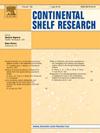Monitoring of marine pollution and stress responses: Radionuclides concentration and antioxidant molecules in macroalgae and seagrass
IF 2.2
3区 地球科学
Q2 OCEANOGRAPHY
引用次数: 0
Abstract
The biological effects of marine radionuclides on the macroalgae Cystoseira crinita and Halopteris scoparia, as well as the seagrass Cymodocea nodosa, were investigated in İzmir Bay. Concentrations of radionuclides 210Pb, 226Ra, 232Th, and 40K were measured in samples of C. crinita and H. scoparia, whereas only 210Pb and 40K concentrations were determined in C. nodosa. In this study, 210Pb concentrations ranged from 11.38 to 31.72 Bq/kg in C. crinita, 19.7–98.02 Bq/kg in H. scoparia, and 26.09–81.27 Bq/kg in C. nodosa. Elevated 210Pb levels in H. scoparia and C. nodosa were observed predominantly during autumn and winter. The 210Po/210Pb activity ratios were found to range between 1.45 and 2.25 in C. crinita, 0.15–1.30 in H. scoparia, and 0.70–1.47 in C. nodosa. The antioxidant defense mechanisms in response to radiation-induced stress were examined in both macroalgae and seagrass samples, focusing on key biomarkers such as ascorbate peroxidase (APX), catalase (CAT), and proline. Correlation analyses were conducted between radionuclide concentrations and antioxidant activity. C. crinita exhibited a defense response to 210Pb exposure similar to that of 210Po, primarily through increased CAT enzyme activity. In C. nodosa, elevated 40K levels were associated with enhanced proline and APX responses, while the accumulation of 210Pb was met with a significant increase in proline-mediated antioxidant defense.
海洋污染和胁迫反应的监测:大型藻类和海草中的放射性核素浓度和抗氧化分子
研究了海洋放射性核素对İzmir湾大型藻类Cystoseira crinita和Halopteris scoparia以及海草Cymodocea nodosa的生物学效应。在荆芥和猪皮草样品中检测到210Pb、226Ra、232Th和40K的放射性核素,而在荆芥样品中仅检测到210Pb和40K的放射性核素。在本研究中,荆芥中210Pb浓度为11.38 ~ 31.72 Bq/kg,猪皮蒿中为19.7 ~ 98.02 Bq/kg,结花蒿中为26.09 ~ 81.27 Bq/kg。冬、秋冬两季,猪皮草和结花草的210Pb含量均明显升高。210Po/210Pb的活性比在荆芥中为1.45 ~ 2.25,scoparia中为0.15 ~ 1.30,nodosa中为0.70 ~ 1.47。研究了大型藻类和海草样品在辐射胁迫下的抗氧化防御机制,重点研究了抗坏血酸过氧化物酶(APX)、过氧化氢酶(CAT)和脯氨酸等关键生物标志物。对放射性核素浓度与抗氧化活性进行了相关性分析。C. criinita对210Pb暴露表现出与210Po相似的防御反应,主要是通过增加CAT酶活性。40K水平升高与脯氨酸和APX反应增强有关,而210Pb的积累则与脯氨酸介导的抗氧化防御显著增加有关。
本文章由计算机程序翻译,如有差异,请以英文原文为准。
求助全文
约1分钟内获得全文
求助全文
来源期刊

Continental Shelf Research
地学-海洋学
CiteScore
4.30
自引率
4.30%
发文量
136
审稿时长
6.1 months
期刊介绍:
Continental Shelf Research publishes articles dealing with the biological, chemical, geological and physical oceanography of the shallow marine environment, from coastal and estuarine waters out to the shelf break. The continental shelf is a critical environment within the land-ocean continuum, and many processes, functions and problems in the continental shelf are driven by terrestrial inputs transported through the rivers and estuaries to the coastal and continental shelf areas. Manuscripts that deal with these topics must make a clear link to the continental shelf. Examples of research areas include:
Physical sedimentology and geomorphology
Geochemistry of the coastal ocean (inorganic and organic)
Marine environment and anthropogenic effects
Interaction of physical dynamics with natural and manmade shoreline features
Benthic, phytoplankton and zooplankton ecology
Coastal water and sediment quality, and ecosystem health
Benthic-pelagic coupling (physical and biogeochemical)
Interactions between physical dynamics (waves, currents, mixing, etc.) and biogeochemical cycles
Estuarine, coastal and shelf sea modelling and process studies.
 求助内容:
求助内容: 应助结果提醒方式:
应助结果提醒方式:


